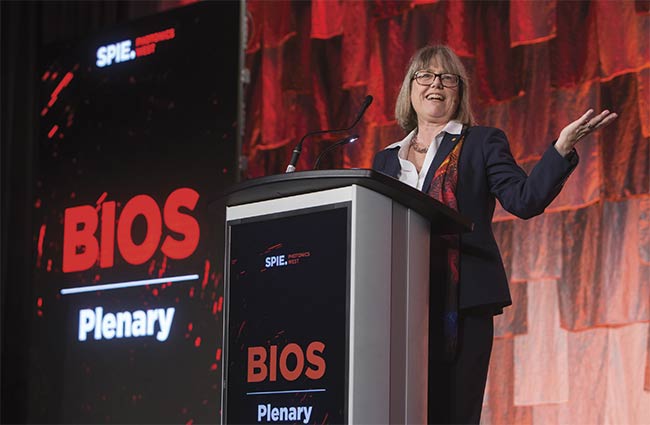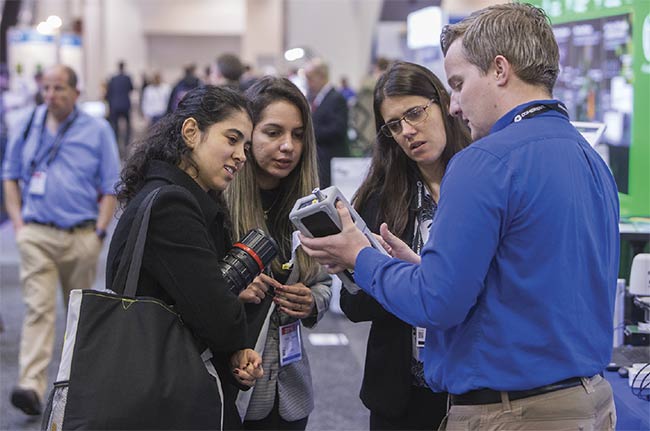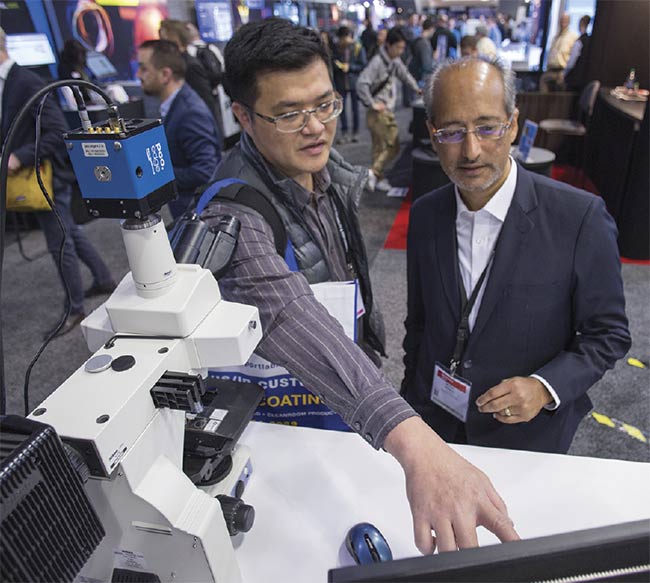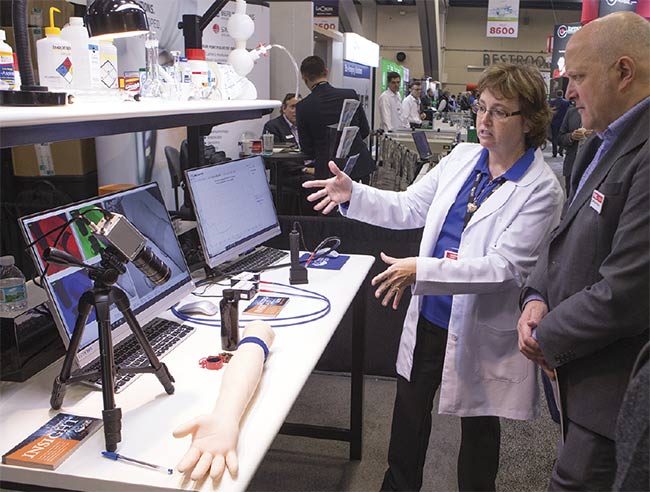A host of researchers and industry experts will descend on SPIE BiOS 2020 in February to expound upon — and demonstrate — the ability of optical technologies to analyze, diagnose, and treat a multitude of medical conditions that clinicians grapple with every day. And while dermatology will be a component of this year’s conference, innovations within the biophotonics sphere have proven to be more than just skin deep, providing key insights into areas such as cardiology, head and neck surgery, and drug treatment with the aid of the latest equipment in microscopy, spectroscopy, lasers, and other imaging techniques.

Donna Strickland, professor at the University of Waterloo in Canada,
was a plenary speaker at last year’s BiOS. She shared the Nobel Prize
in physics in 2018. Courtesy of SPIE.
Much like the technologies that offer an ever-clearer picture of human health, the conference will provide a view of trends in the universities and laboratories across the country and around the world, tapping into the work of young research assistants, tenured professors, scientists, and laboratory technicians. Many such attendees will be given a voice at BiOS, via their own talks, by lending their hands in the preparation of material for a host of sessions, or by competing in poster contests for recognition from their peers.
BiOS 2020, a part of SPIE Photonics West, will be held at the Moscone Center in San Francisco on February 1 and 2. The conference will be overseen by symposium co-chairs Jennifer Barton of the University of Arizona and Wolfgang Drexler of the Medical University of Vienna.

BiOS attendees view a demonstration of hand-held equipment. Courtesy of SPIE.
“The biophotonics community gathers at Photonics West every year, with the best and the brightest researchers from across the globe presenting their latest work and networking with their colleagues,” said Marilyn Gorsuch, SPIE’s senior director of technical programs and proceedings, who is also the event manager for Photonics West. “BiOS has become a reliable meeting place for attendees to touch base with their collaborators from a wide and exciting variety of countries and institutions.”
Following welcoming remarks by Barton and Drexler on Saturday, February 1, SPIE will present the 2020 Britton Chance Biomedical Optics Award. Featured “Hot Topics” talks that day will include “Optical Coherence Tomography, from Research to Clinical Practice,” “Multiscale QPI,” “X-Induced Photodynamic Therapy,” and “AI Cell Sorting.”

A BiOS attendee receives an explanation about key features of a sCMOS camera. Courtesy of SPIE.
On Sunday, Eric Betzig of the University of California, Berkeley and the Howard Hughes Medical Institute will give a special plenary presentation, “Spying on the Secret Lives of Cells.” Betzig was the 2014 winner of the Nobel Prize in Physics.
Application tracks
Sessions at the BiOS conference will be divided into six tracks:
Photonic Therapeutics and Diagnostics.This segment will include sessions focusing on therapeutics in urology, lasers in dentistry, and molecular-guided surgery.
It is co-chaired by Brian Jet-Fei Wong of the Beckman Laser Institute and Medical
Clinic at the University of California, Irvine and Eva Sevick of the University of Texas Health Science Center.

A crowd gathers to listen to a plenary speech at last year’s BiOS conference. Courtesy of SPIE.
Neurophotonics, Neurosurgery, and Optogenetics. Topics in this track will include clinical and translational neurophotonics, neural imaging and sensing, and optogenetics and optical manipulation. It is co-chaired by David A. Boas of Boston University and Elizabeth Hillman of Columbia University.
Clinical Technologies and Systems. This track will include topics on optical coherence tomography and coherence domain optical methods in biomedicine; optical fibers and sensors for medical diagnostics and treatment; biomedical vibrational spectroscopy; and biophotonics in exercise science, sports medicine, health-monitoring technologies, and wearables. It is co-chaired by Tuan Vo-Dinh of Duke University and Anita Mahadevan-Jansen of Vanderbilt University.
Tissue Optics, Laser-Tissue Interaction, and Tissue Engineering. This segment will include discussion of optical interactions with tissue and cells; imaging and sensing; and optical elastography and tissue biomechanics. It is co-chaired by E. Duco Jansen of Vanderbilt University and Jessica Ramella-Roman of Florida International University.

An exhibitor shows how information is gathered in sample analysis. Courtesy of SPIE.
Biomedical Spectroscopy, Microscopy, and Imaging. Subjects within this track include multiphoton microscopy in the biomedical sciences, optical diagnostics and sensing, point-of-care diagnostics, and biomedical applications of light scattering. It is co-chaired by Ammasi Periasamy of the University of Virginia and Daniel Farkas of the University of Southern California and Spectral Molecular Imaging Inc. (SMI).
Nano/Biophotonics. Topics in this segment include nanoscale imaging, sensing, and actuation for biomedical applications; reporters, markers, dyes, nanoparticles, and molecular probes for biomedical applications; and plasmonics in biology and medicine. It is co-chaired by Paras Prasad of the University of Buffalo and Ewa Goldys of the University of New South Wales.
Best paper awards
Sponsored by businesses including ThorLabs, Johnson & Johnson, and Seno Medical, up-and-coming researchers and scientists will be honored by SPIE for best papers. Categories for paper awards include therapeutics and diagnostics in urology; diseases in the breast and reproductive system; the Pascal Rol Award for ophthalmic technologies; microfluidics, bioMEMS, and medical microsystems; and the Seno Medical best paper award for imaging and sensing. Other awards include the JenLab Young Investigator Award for best paper on multiphoton microscopy in the biomedical sciences; the PicoQuant Young Investigator Award for best paper on single-molecule spectroscopy and superresolution imaging; a best paper award for high-speed biomedical imaging and spectroscopy; the Prizmatix Young Investigator Award for best paper on nanoscale imaging, sensing, and actuation for biomedical applications; the Ocean Optics Young Investigator Award for best paper on colloidal nanocrystals for biomedical applications; and a student poster session for multiphoton microscopy in the biomedical sciences.
BiOS Expo
The BiOS Expo, to be held both days of the conference, will include 200 companies putting their equipment, components, and systems for therapeutic lasers, microscopic imaging, and biosensors and much more on display at the world’s largest biomedical optics and biophotonics exhibit. Companies bringing their cutting-edge technology and expertise to bear for the benefit of attendees will include Excelitas Technologies Corp., Mad City Labs Inc., ASI Inc., Berliner Glas, Edmund Optics Inc., FORC-Photonics, Fresnel Technologies Inc., and HORIBA Scientific. For a full list of exhibitors, visit www.spie.org/exhibitor/search.aspx?expo=spie-bios-2020.
For more information about SPIE BiOS 2020, visit www.spie.org.